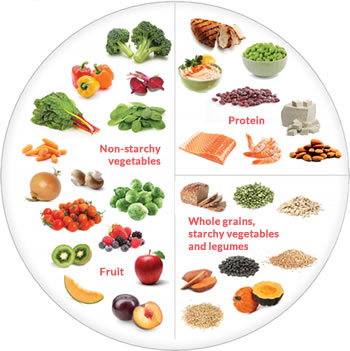My Heart Healthy Plate

Nutrition plays such an important role in the fight against heart disease. Use the My Heart-Healthy Plate guide to help you make smart choices about the food you eat.

Fill half your plate with a variety of non-starchy vegetables, such as leafy greens, broccoli, carrots, peppers or cabbage, and whole fruit. Eat more vegetables than fruit. Limit juice and dried fruits.

Fill a quarter of your plate with protein sources such as fish, skinless poultry, beans, lentils, nuts and tofu. Limit red meat and cheese; avoid processed meats such as cold cuts and bacon.

Fill a quarter of your plate with whole grains, such as brown rice, whole-wheat pasta, barley, quinoa,oats or whole-wheatbread, or other healthy starches including sweet potatoes, acorn squash, beans or lentils. Limit white bread, white rice, and fried potatoes.
Choose small amounts of healthy oils (such as olive and canola) for cooking or to flavor foods. Nuts, seeds and avocados also contain healthy fats. Limit or avoid butter, lard, tropical oils (coconut, palm), and stick margarine.
Choose one to three servings of non-fat (skim) milk or yogurt every day; non-dairy alternatives such as soy, rice, or almond milk are fine. A serving is 8 oz. Choose yogurt with less than 15 grams of sugar per serving.
Drink mostly water or other calorie-free beverages, such as coffee or tea. Avoid sugary drinks.
For more information about preventing heart disease, visit OHSU's Heart Disease Prevention Program.
Physical activity
Daily physical activity is essential for a healthy heart. The goal is at least 30 minutes, 5 days a week of walking or other exercise. This can be done in 10-minute sessions if needed.

Spend more time moving and less time sitting. Use a pedometer to track your daily activity, aiming for 10,000 steps every day.